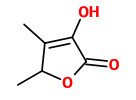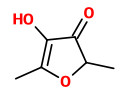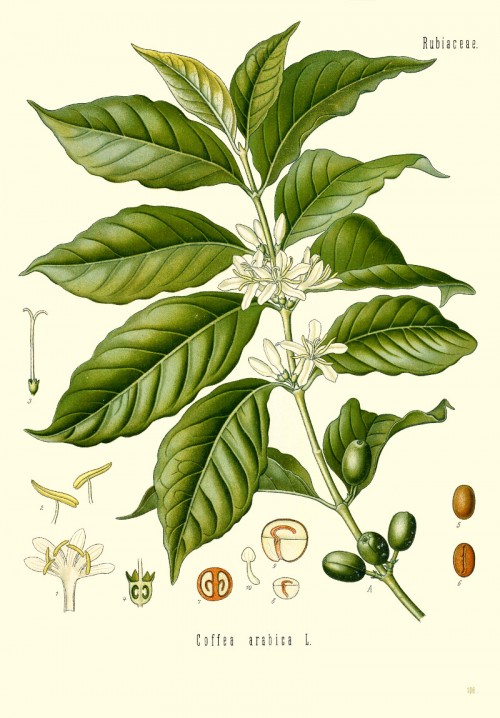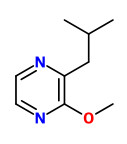Dies ist eine alte Version des Dokuments!
Coffea arabica L. - Rubiaceae - coffea arabica, Arabian coffee, Abyssinian coffee, Arabica-Kaffee
Small trees or large shrubs, 5-8m tall, native to Etiopia, cultivated in moist, usually cool tropical regions. „This species is tetraploid and is the source of „Arabica Coffee.“ It has been widely hybridized with several other Coffea species to produce commercial coffee plants; flower size varies markedly among many of these.“ http://www.efloras.org/florataxon.aspx?flora_id=2&taxon_id=200022076
„Coffea arabica is believed to be the first species of coffee to be cultivated, being grown in southwest Ethiopia for well over 1,000 years.“ http://en.wikipedia.org/wiki/Coffea_arabica
„The volatile components of roasted Arabica and Robusta coffees (powder and brew) were analysed by gas chromatography-olfactometry (GC/O) which revealed the odorants having the highest odor-activity values (ratio of concentration to odor threshold). This procedure resulted in 38 odorants of which 32 were identified. The powders of the two coffee varieties differed in the concentration levels of these compounds. The results indicate that the flavor difference between Arabica and Robusta coffee (powder and brew) are mainly due to the predominance of enoloxo compounds (sotolon, abhexon, furaneol, 3,4-dimethyl-2-hydroxy-2-cyclopentenone) in the former and of 3,5-dimethyl-2-ethylpyrazine, 2,3-diethyl-5-methylpyrazine, 4-ethylguaiacol and 4-vinylguaiacol in the latter. Preparation of brews enhanced the flavor difference, as the concentration levels of water-soluble odorants (furaneol, sotolon, abhexon) responsible for the “sweet-caramel” flavour note increased more in the Arabica than in the Robusta coffee. On the other hand, the alkylpyrazines and guaiacols were responsible for the “spicy, harsh-earthy” aroma of the Robusta coffee. Quantification of selected odorants using a stable isotope dilution assay confirmed the differences between the Arabica and Robusta coffees (brew) found by GC/O.“
[Aroma impact compounds of arabica and robusta coffee. Qualitative and quantitative investigations. Blank, I., Sen, A.,Grosch, W., In Quatorzieme colloque scientifique international sur le cafe, San Francisco, 14-19 juillet 1991, 117-129)]
 sotolon (3-hydroxy-4,5-dimethyl-2(5H)-furanone, caramel furanone) |  furaneol (4-hydroxy-2,5-dimethyl-3(2H)-furanone) |  2-ethyl-3,5-dimethylpyrazine |  4-vinylguaiacol |
„… aroma freshness of whole roasted coffee is mainly determined by certain low-boiling components, namely low-molecular weight sulphur compounds, Strecker aldehydes and α-dicarbonyls. The loss of aroma freshness was due to the loss of certain aroma impact volatiles, mainly methanethiol, which then could be used as an indicator of freshness. The heavier components, such as furfurylmercaptan, will remain in the coffee and will cause an ‘ageing’ note. In addition, an increase of dimethylsulphide, the oxidation product of methanethiol, was observed, although no ‘true’ staling compound was found.“
[Steinhart H, Holscher W. In Proceedings of the 14th ASIC Meeting, San Francisco, 1991, 156-164]
[Coffee flavour: an overview., Buffo, R.A., Cardelli-Freire, C., Flavour and fragrance journal, 19(2), 2004, 99-104] http://www2.hcmuaf.edu.vn/data/lhquang/file/Coffee/coffee%20flavour.pdf
„The potent odorants were quantified in a sample of roasted Arabica coffee. On the basis of the results, 27 odorants were dissolved in an oil/water mixture. The flavor profile of the model obtained was very close to that of the real sample. In duo and triangle tests, the model was compared with models missing one or more odorants. These experiments indicated that 2-furfurylthiol, 4-vinylguaiacol, several alkyl pyrazines, furanones, acetaldehyde, propanal, methylpropanal, and 2- and 3-methylbutanal had the greatest impact on the coffee flavor.“ The omission experiments for 2-furfurylthiol confirmed that it is a key component of coffee
flavour but has much lower impact in the coffee beverage due to its lower yield in the brewing process.
[Sensory study on the character impact odorants of roasted Arabica coffee., Czerny, M., Mayer, F., Grosch, W., Journal of Agricultural and Food Chemistry, 47(2), 1999, 695-699]
 furfuryl mercaptan (2-furfurylthiol)
furfuryl mercaptan (2-furfurylthiol)
„The more potent odorants in a sample of medium-roasted Arabica coffee and in the corresponding brew were quantified. Large amounts ( >75%) of acetaldehyde, 2,3-butanedione, 2,3-pentanedione, vanillin and some furanones were extracted from the coffee brew, whereas the yields of the more unpolar compounds, such as 3-isobutyl-2-methoxypyrazine, (E)-β-damascenone and the unstable 2-furfurylthiol were low (<25%). On the basis of quantitative data an aroma model was prepared for the brew. In triangle tests, models containing the complete set of 24 odorants were compared with a model missing one or more odorants. These experiments indicated that the aroma of the brew was mainly caused by some alkylpyrazines, furanones and phenols, and by 2-furfurylthiol, methional and 3-mercapto-3-methylbutyl formate. The higher impact of both methional and the formate on the aroma of the brew and the lower aroma activity of 4-vinylguaiacol were in contrast to results obtained in a previous study for ground coffee of the same provenance and roast degree.“
[Sensory study of the character impact aroma compounds of a coffee beverage., Mayer, F., Czerny, M., Grosch, W., European Food Research and Technology, 211(4), 2000, 272-276]
An aroma model including 22 substances (found in roasted coffee headspace: methanethiol, acetaldehyde, methylpropanal, 2-methylbutanal, 3-methylbutanal, 2,3-butanedione, 2,3-pentandione, (E)-ß-damascenone, 2-furfurylthiol, methional, guaiacol, 4-ethylguaiacol, 4-vinylguaiacol, vanillin, 2-ethyl-3,5-dimethyl-pyrazine, 2,3-diethyl-5-methyl-pyrazine, 2-isobutyl-3-methoxy-pyrazine, 2-ethenyl-3,5-dimethyl-pyrazine, 4-hydroxy-2,5-dimethyl-3(2H)-furanone, 2-ethyl-4-hydroxy-5-methyl-3(2H)-furanone, 3-hydroxy-4,5-dimethyl-2(5H)-furanone) was able to simulate the odour of freshly ground coffee powder, rating 2.6 on a scale from 0 (no similarity) to 3.0 (identical). A reduced model including 9 substances scored 2.1. It consisted of acetaldehyde, methylpropanal, 2- and 3-methylbutanal, 2,3-butanedione, 2,3-pentanedione, 2-furfurylthiol, 2-ethyl-3,5-dimethylpyrazine and 2,3-diethyl-5-methylpyrazine.
[Aroma simulation on the basis of the odourant composition of roasted coffee headspace., Mayer, F., Grosch, W., Flavour and fragrance journal, 16(3), 2001, 180-190]
2-isobutyl-3-methoxypyrazine „… is the most aroma-active constituent of raw coffee and is stable during roasting,… so roasting of the raw material not only produces the pleasant aroma which is characteristic for coffee but, in addition, generates odorants which suppress the peasy odour note [of 2-isobutyl-3-methoxypyrazine].“
[Evaluation of the key odorants of foods by dilution experiments, aroma models and omission., Grosch, W., Chemical senses, 26(5), 2001, 533-545] http://chemse.oxfordjournals.org/content/26/5/533.full
„Volatile organic compounds (VOCs), emitted from green coffee beans, during coffee roasting and from a cup of coffee, were all analysed by proton-transfer-reaction mass spectrometry. Firstly, the headspace (HS) of green beans was investigated. Alcohols dominate the HS, but aldehydes, hydrocarbons and organic acids were also abundant. Secondly, we roasted coffee under two different conditions and monitored on-line the VOCs emitted during the process. In a first roasting series, a batch of beans was roasted. After an initial drying phase, dominated by evaporation of water and methanol, the HS concentrations of VOCs such as acetic acid, acetaldehyde, pyridine and methylbutanal rapidly increased and went through a maximum at medium roast level. In a second series, just six beans were roasted. We observed sporadic bursts of some volatiles (furans, butanal, 2,3-pentanedione), coinciding with popping sounds. Other VOCs showed smooth time-intensity profiles (pyridine, pyrazine). These experiments gave a real-time insight into the complex processes taking place during roasting. Finally, the HS of coffee extracts, prepared from beans roasted to different roast levels, were analysed. Most VOCs showed a maximum concentration at medium roast level (e.g. pentanedione, furfural, 5-methyl furfural), while others showed a gradual increase (e.g. pyrrol) or decrease (e.g. methanol).“
[From the green bean to the cup of coffee: investigating coffee roasting by on-line monitoring of volatiles. Yeretzian, C., Jordan, A., Badoud, R., Lindinger, W., European Food Research and Technology, 214(2), 2002, 92-104]
„ …as concerns the Arabica class, the El Salvador sample was characterized by higher amounts of ketones (2,3-butanedione, 2,3-pentanedione, 1-hydroxy-2-butanone), especially diketones and aldehydes (2-methylbutanal, 3-methylbutanal, furfural), in particular butanal derivatives. Costa Rica coffee presented the most abundant substituted pyrazine fraction (2,5-dimethylpyrazine, 2,6-dimethylpyrazine, ethylpyrazine, 2-ethyl-6-methylpyrazine, 2-ethyl-5-methylpyrazine, 2-ethyl-3-methylpyrazine). Furthermore, it was characterized by the highest amount of guaiacol (0.526%) and the lowest amount of pyridine (5.181%). Santos coffee followed more or less the same behaviour with the exception of some of the furfuryl compounds (furfuryl alcohol, furfuryl ether) which were more concentrated in this matrix.“
[Reliable characterization of coffee bean aroma profiles by automated headspace solid phase microextraction‐gas chromatography‐mass spectrometry with the support of a dual‐filter mass spectra library., Mondello, L., Costa, R., Tranchida, P.Q., Dugo, P., Lo Presti, M., Festa, S., Dugo, G., Journal of separation science, 28(9‐10), 2005, 1101-1109]
Chlorogenic acid-rich green coffee extract is used to induce weight loss. Giving 200mg extract or placebo twice a day with the main meal for 60 days, changes in weight were -4.9kg in verum and -2.4kg in placebo group; body mass index (BMI) changes observed were -1.9 (verum) and -0.9 (placebo). It was suggested that chlorogenic acid is able to lowering blood sugar by inhibition of hepatic glucose-6-phosphatase.
[Svetol, green coffee extract, induces weight loss and increases the lean to fat mass ratio in volunteers with overweight problem., Dellalibera, O., Lemaire, B., Lafay, S., Phytotherapie, 4(4), 2006, 194-197] http://www.realdose.com/wp-content/uploads/2012/01/Effect_of_Svetol_on_weight_loss_on_humans.pdf
Though chlorogenic acid (1mM) inhibited about 40% of glucose-6-phosphatase activity in the microsomal fraction of hepatocytes, no effect was observed on production of glucose from gluconeogenesis or on L-alanine catabolism at various concentrations in liver perfusion experiments. It is possible that this compound did not reach sufficiently high intracellular levels to inhibit the target enzyme. Intravenous administration of chlorogenic acid also failed to provoke a reduction in blood glucose levels. Chlorogenic acid promoted a significant reduction in the plasma glucose peak at 10 and 15 min during the oral glucose tolerance test (OGTT), probably by attenuating intestinal glucose absorption.
[Chlorogenic acid reduces the plasma glucose peak in the oral glucose tolerance test: effects on hepatic glucose release and glycaemia., Bassoli, B.K., Cassolla, P., Borba‐Murad, G.R., Constantin, J., Salgueiro‐Pagadigorria, C.L., Bazotte, R.B., de Souza, H.M., Cell biochemistry and function, 26(3), 2008, 320-328]

Köhler,F.E., Medizinal Pflanzen, vol.2 t.106 (1890)
http://plantgenera.org/species.php?id_species=262279

